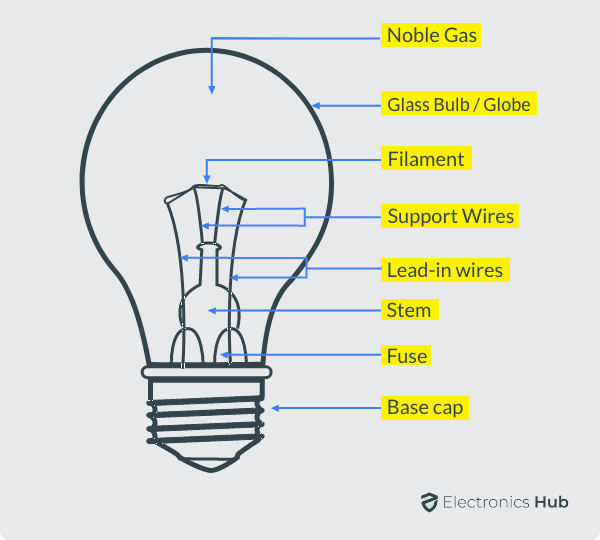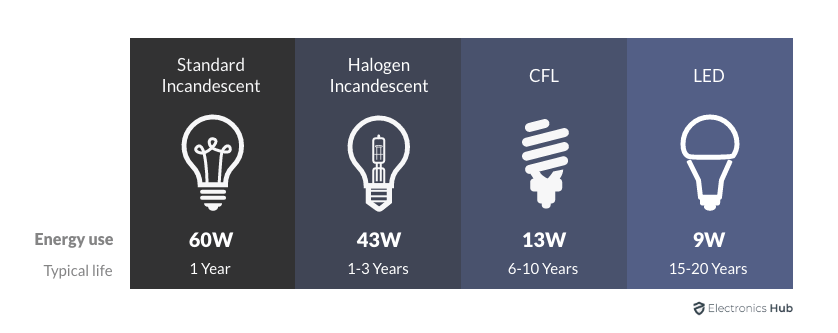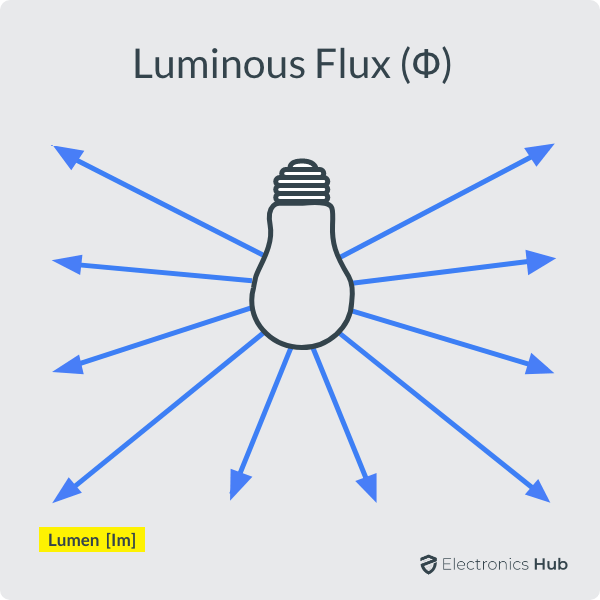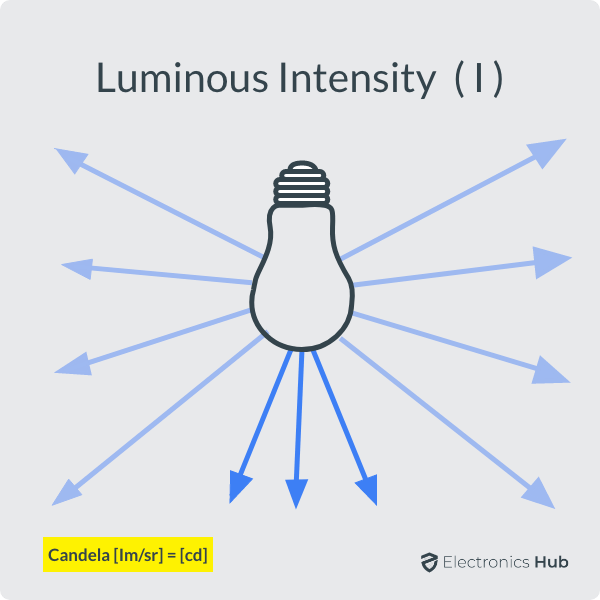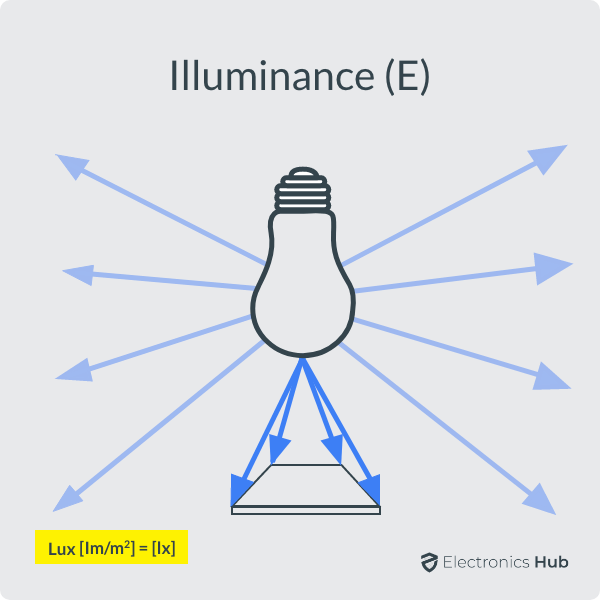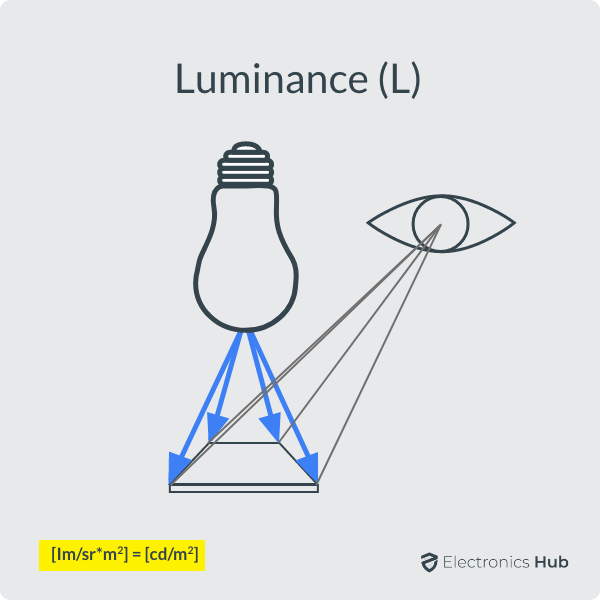Up until the late 19th century, the main source of artificial lighting has been by burning of vegetable oil, animal oil, fat and waxes. A wick is used to control the amount of fuel that is being burnt and thus the mount of light it produces. Things changed with the invention of Incandescent Bulb, a source of light that is ‘fueled’ or powered electricity. With the widespread availability of electricity and a significant amount of technological effort into making better lighting systems, modern electricity based light sources come in a variety of shapes, sizes and types for all kinds of applications.
Outline
ToggleTypes of Light Sources
Almost all the artificial sources of Light work on two principles. They are:
- Incandescence
- Luminescence
Incandescence is a phenomenon where a visible light (as a part of the Electromagnetic Radiation) is produced by heating (or raising the temperature) of a solid body. The best example of this type of light source is the Incandescent Light Bulb, where a filament (usually Tungsten) is supplied with electric current and it produces light as it heats up.
Luminescence is a phenomenon where a visible light is produced by not heating the substance. The light produced due to luminescence can be caused by several entities such as electrical energy, chemical reaction, excitation of electrons etc. The light produced by Incandescence is often described as ‘hot light’ where as the light produced by luminescence is called ‘cold light’. There are several types of Luminescence phenomena and a commonly used one is the Fluorescence. Mercury based Fluorescent Lamps work on this principle.
Light Bulb Types
Let us now see some of the Different Types of Light Bulbs or Lamps. The three main Light Bulb Types are:
- Incandescent Bulbs
- Fluorescent Bulbs
- LEDs (Light Emitting Diodes)
These three are the main types of light bulbs used for residential and office use. In this, the Incandescent Bulbs are considered obsolete. Fluorescent Bulbs on the other hand, despite being energy efficient than incandescent bulbs, are gradually being phased out due to use of toxic substances (Mercury) in them and also increased availability of LEDs.
Speaking of LEDs, they are the most energy efficient of the three and as the prices of LEDs are coming down year-by-year, the adaptation of LEDs into home, offices, commercial buildings, etc. is steadily rising.
Apart from these three light bulbs, there are other types of bulbs that are used in industrial, automotive, city lights and other commercial applications. Some of the popular light bulbs other the three main light bulbs are:
- Metal Halide Lamps
- Sodium Vapor Lamps
- Mercury Vapor Lamps
Let us now see about some of the important and popular types of Light Bulbs.
Incandescent Bulb
The invention of Incandescent Bulb is an important moment in the history of human existence. Even though there were few other types of electric bulbs before the incandescent bulb, the impact of incandescent light bulb on artificial lighting was very huge.
An Incandescent Light Bulb is the simplest of all the light bulbs mentioned here. It contains a glass globe filled with a noble gas to prevent oxidation. At the center of the globe, there is a metal filament wire, through which electricity passes. The filament heats up as electric current passes through it and as a result, it emits electromagnetic radiation in the form of visible light.
In the early days, the filament used in incandescent bulbs was made of Carbon. After experimenting with few other filament materials (even Platinum was once used), Tungsten was finally chosen as the filament due to its very high melting point. The following image shows a typical incandescent light bulb with all its components.
Important Points
- Once widely used in residential as well as commercial lighting.
- Gradually being phased out due to their poor energy efficiency.
- Cheapest of all the light bulbs mentioned here.
- Very good CRI. The value is almost equal to 100.
- More than 95% of energy is dissipated as heat.
- Very simple devices with low manufacturing cost.
- Doesn’t need any special circuit or electronics. Directly connect to power supply (AC or DC) and they start to work.
Fluorescent Lamps
The fluorescent lamps (both long tubes as well as compact lamps – CFLs) are a type of Gas Discharge Lamps, which produce light when electricity is passed through an ionized gas.
Most lamps use noble gases such as Argon or Neon along with other materials such as Mercury, Sodium and Metal Halides. The electrons in the ionized gas gets excited when electric current is passed. The change in the characteristic energy of the electrons results in emission of photons (in Ultraviolet, Visible as well as Infrared Radiations).
These radiations are converted to visible light by coating the inside of the tube with fluorescent element.
Both long tube style and compact fluorescent lamps (CFL) are considered to be low-pressure Gas Discharge Lamps as the maximum pressure in these lamps is around 0.3% of atmospheric pressure.
Fluorescent Tubes and CFLs are the main alternative to incandescent bulbs due to their low energy consumption and longer life.
Important Points
- Used in large commercial buildings, offices, shops as well as homes.
- The luminous efficiency is better than that of incandescent bulbs.
- Very low CRI values among the three.
- Mercury based fluorescent lamps are not being manufactured due to toxic substances.
- Needs an electronic circuit (called Ballast) for proper power supply.
Light Emitting Diodes or LEDs
The development of Light Emitting Diodes or simply LEDs is another important achievement in the field of Technology. LEDs are semiconductor devices that works on the Electroluminescence phenomenon. An LED is essentially a PN Junction Diode that emits light when it is forward biased.
Despite the benefits of extreme low power consumption and reasonably long life, the first LED Light Bulbs are extremely costly, which made the users not to opt them but rather invest in relatively cheap CFLs.
As the years passed by, the cost of LED Light Bulbs has come down gradually and the push from Governments and environmentalists led to investment in LED based lighting in offices, commercial complex, street lights. Now-a-days, almost majority of lighting in homes, offices, cars, streets, etc. is based on LEDs.
The main advantage of LEDs is its Luminous Efficiency or Lumens per Watts ratio. It describes the number of watts a light source consumes to produce a certain lumen of light. Of the three light bulbs mentioned here, LEDs have the best lumen per watt figures.
For example, a 40W incandescent light bulb may produce light between 500 – 600 lumens. For the same number of lumens, a CFL will consume around 12 – 15 Watts while an LED will consume only 8 – 10 Watts.
Coming to the other important parameter of a light source i.e., its CRI or Color Rendering Index. While incandescent light bulbs have near 100 CRI (which is the maximum possible value), the starting CRI of LEDs is around 80. But LEDs with higher CRI values (as high as 95 – 98) are also available for accurate color representation.
With low power consumption, long life time and gradually decreasing prices, choosing LEDs over incandescent and CFL is a very choice. In LED, there is no energy wasted a heat or they don’t contain any toxic substances.
Important Points
- Lowest energy consumption per lumen figures between the three light bulb types.
- Have significantly longer life time. Depending on the brand and manufacturer, some LEDs can last up to 10 years.
- Originally used in signaling and for lighting up signs, now almost all the lighting in homes, commercial spaces, offices, automobiles, streets, etc. is being converted to LED based lighting system.
- Apart from general lighting (normal household lights), LEDs are also available for decoration, emergency lighting, solar based lighting, etc.
Important Parameters used in Lighting
Let us now learn about some of the basic parameters about a typical light source. The parameters are:
- Luminous Flux
- Luminous Intensity
- Illuminance
- Luminance
Luminous Flux
The Luminous Flux of a light source describes the amount of light it emits. Luminous Flux is measured in Lumens (lm). It is usually represented by Greek Alphabet Phi (Φ).
Another important quantity based on Luminous Flux is the Luminous Efficiency, which measures the economic efficiency of a light source. If we have the luminous flux (Φ) of a light source in lumens (lm) and also its power consumption in Watts (W), then the luminous efficiency is the ratio of luminous flux and power consumption (lm / W).
Luminous Intensity
It is a measure of amount of light that is radiated in a particular direction. Luminous Intensity is represented by ‘I’ and has a units Candela (cd). The Luminous Intensity Distribution Curve or LDC is used to represent the Luminous Intensity.
Illuminance
The Illuminance of a light source is the measure of the amount of Luminous Flux falling on a surface. It is represented by ‘E’ and has units Lux (lx). Luminous Flux is measured in ‘lm’ and area is measured in ‘m2’. So,
Illuminance E in lx is Luminous Flux in lm / Area in m2
Luminance
Finally, we have the Luminance of a light source. It is the only lighting parameter that is perceived by the subject. It is a measure of the degree of brightness of a light source on a particular surface. Since Luminance depends on the degree of reflection from the surface, it varies from one surface to other as the color and type of surface decides the luminance numbers.
It is represented by ‘L’ and has units Candela / meter2 (cd / m2).
How to Choose the Right Light Bulb?
Choosing the right light bulb for your home or office is very important as it can affect your health, productivity, energy consumption and many other aspects.
Check for Lumens, Not Watts
If you have ever purchased incandescent light bulbs (when they were common and available everywhere), you probably would have asked for a bulb based on its wattage as in a 40W bulb, a 60W bulb or a 100W bulb.
But we cannot follow the same strategy for the modern energy efficient light bulbs as they produce more light and consume very less power. Then, how to choose the right light bulb?
Assuming you are buying an LED Light Bulb, instead of shopping for Watts, you have to look for the Lumens of the Light Bulb. As mentioned earlier, Lumens is the unit of luminous flux, which describes the quantity of the light produced by a light bulb (or any light source).
For example, a 60W incandescent bulb might produce around 700 lumens of light. Now, an LED light bulb which produces the same amount of light will consume only 10W.
Lifetime Cost
While an incandescent bulb may be cheaper, its life time is typically around 1 year. At the same time, the cost of an LED Light Bulb is slightly higher than other bulb types (both incandescent and CFL), but an LED Light Bulb has a life time in the range of 5 to 10 years. Considering the energy savings and longer life time of LEDs, choosing an LED over incandescent or CFL is a no brainer.
NOTE: The cost of LED Light Bulbs has come down significantly over the years and I believe it will continue to decrease as production of LEDs is now going on a very large scale and the cost of raw material is also low.
Color Temperature
The color temperature of a light bulb, which is measured in Kelvin, describes the amount of hue a light bulb can provide i.e., whether the light is warm or cool.
While almost all the incandescent light bulbs produce warm white light, you have an option to choose the right color temperature if you are planning to buy a CFL or an LED.
Color Temperatures in the range of 2700K to 3200K are considered warm white and it is the usually value for incandescent bulbs (regular or halogen).
The color temperatures between 4000K to 4800K are considered normal white, which is close to direct Sun light.
Finally, the color temperatures around 5000K represent a normal daylight and as value goes higher, the light looks cooler.
Color Rendering Index (CRI)
CRI of a light bulb is a measure of the true representation of the color of an object under the light from that bulb. Incandescent bulbs have near 100 CRI while fluorescent lamps have a CRI in the range of 50 to over 95.
Coming to LEDs, most LEDs have a CRI of around 80. Some LEDs have high CRI with manufacturers claiming values to be as high as 98.
Choosing bulbs with high CRI is important especially if you are a photographer or a content creator.
General Lighting or Task Specific Lighting
The ambient light of a room is usually achieved by a single large source of light place at the center of the room. Light from this bulb is spread out all over the room with a good brightness.
In addition to general lighting, you can also install task specific lighting. For example, while a kitchen has a general light like all other rooms, having a small light over the kitchen counter is very useful. You can choose the appropriate lighting based on your needs.
Such task specific lights can also be placed in bathrooms, study tables, office desks and many more places.
The following table shows some of the common lighting applications and choices of light bulbs you can use for that lighting setup.
 |  | |||
 |  | |||
 |  | |||
 |  |  | ||
 | 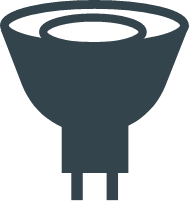 | 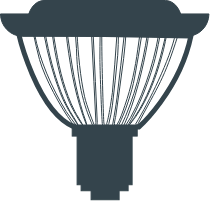 |  | |
 |  |  |  | |
 |  | |||
Conclusion
A simple guide about Different Types of Light Bulbs that are available today in the market. You learned about light bulb types, their advantages, disadvantages and applications and also few tips on how to choose the right light bulb for your home or office.

